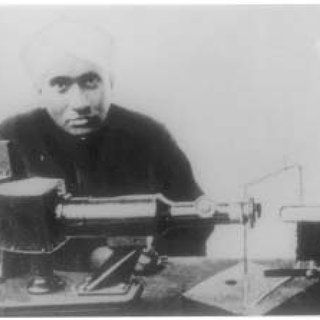STANDING TALL WITH RAMAN’S LEGACY
STANDING TALL WITH RAMAN’S LEGACY
The National Science Day is celebrated in India to reminisce the landmark discovery of the Raman Effect by our eminent physicist Sir C.V. Raman on February 28, 1928, and his subsequent felicitation of the Nobel Prize as the first Asian in Physics. The life of Raman has several important points to be chronicled that should be reflected upon and imbibed by our young generation today. First, Raman published his first scientific paper entitled ‘Unsymmetrical diffraction bands due to a rectangular aperture" in the British journal ‘The Philosophical Magazine’ in 1906 while he was a graduate student of only 18 years old. This shows that inclination for path-breaking discoveries should be occupied in one’s mind at a very early age. Second, he contradicted with Lord Rayleigh, the eminent British physicist of that time regarding the explanation for the blue colour of the sea which he believed due to the reflection of the blue sky. Rather than being dogmatic in accepting the prevailing view, Raman tried to verify the theory during his voyage from Southampton to Bombay in 1921. While passing through the Mediterranean aboard the steamship SS Narkunda, he was so intrigued by the blue colour of the sea that while most of his co-passengers were enjoying the thrilling voyage of the sea, he immediately carried out a series of improvised experiments on the deck with a few tool from his pocket to conclude that the blue colour of the sea was actually due to the predominant scattering of the blue wavelength of the sunlight by the water particles. It theoretically proved the Rayleigh explanation wrong and, hence, represented the unfolding of a revolutionary idea from the Eastern world breaking the monopoly of the scientific supremacy of the West. Thirdly, Raman quit the lucrative post of Assistant Accountant General in 1907 held in the Indian Financial Service in Kolkata to join as the Palit Professor of Physics in the University of Calcutta at nearly half of the salary just for the sheer love for scientific research. Fourthly, although two contemporary Russian physicists namely G.S. Landsberg (1890-1957) and L.I. Mandelstam (1879-1944) were also working on the same field of scattering of light by liquid particles and almost have discovered the effect, it was the wisdom of Raman who mailed the paper first to the British journal ‘Nature’ for publication to write his name among the Nobels. Finally, the fact that Raman discovered the Effect with the help of a Spectrometer that cost hardly five hundred rupees at that time proved that path-breaking discoveries in science can also be achieved even by one’s own ingenuity and original approach rather than the instrumentation superiority of a country.
However, it
is lamenting to note that despite this rich legacy in scientific pursuit, Indian
youth currently are more attracted to careers in technology rather than
fundamental research in pure science. This is the reason why the country is now lagging
far behind in the field of scientific research compared to other nations of the
world. It is also shocking to note that the country has not been able to
produce any world-class scientist to bag the world’s coveted prize even 90
years after Raman. The state of poor research in India is evident from the fact
that the country has reportedly only 140 researchers per 1,000,000 population as
compared to 4651 in the US and that India ranks 34th in global spending on scientific research and
development as India’s Gross Expenditure on Research and
Development (GERD) in Science and Technology stands around 0.7% of its GDP which is far lower compared to nations
like Israel (4.6 %), South Korea (4.5 %), Japan (3.2 %), Germany (3.0 %), USA
(2.8 %), France (2.2 %), UK (1.7%), Canada (1.6 %), China ( 2.1%), Brazil (1.3 %)
and Russia (nearly 1 %). India has also fewer world-class
research institutes and universities to catalyze and support its research
activities. Indian research and
manufacturing industries, both in the private and public sector, filed only 1428
international patent applications in 2014 as compared to 42,381 by Japan,
25,548 by China, and 13,117 by South Korea.
The dismal performance
can be attributed to the poor quality of research work in India, pitiable
market value for its products and the lengthy period of research by an individual.
It is also shocking to note that most Indian companies including those in the IT
and infrastructure sectors spend only less than one per cent of their revenues
on R&D.
For a country, scientific research is not just a revenue generator, but a long-term asset expected to bring about new technological innovations as a fillip to the economy required for national development. Hence, India should not only be investing more in scientific research by expanding its research base, but also should assert to its younger citizens that a career in this domain is indeed rewarding. Raman’s legacy would go a long way to bolster our scientific research to new heights in days to come.
Nikunja BIhari Sahu
Education Officer
Regional Science Centre
Bhopal
Phone: 8917637974
To read the same article published in The Orissa Post dated 28.02.24and 28.02.25 , pl click the following link :
https://drive.google.com/file/d/1D-M8270hSWKtTU305LypF7ySYI5gnlnB/view?usp=sharing
&
https://drive.google.com/file/d/11qawi45-EnzmAqyDHo59w2CVw2T-_QH5/view?usp=sharing
To read the same article published in The Orissa Post dated 28.02.22 , pl click the following link :
https://drive.google.com/file/d/133me-MohechTCkOBrGCbTqcLXHQbZ6tu/view?usp=sharing





Comments
Post a Comment